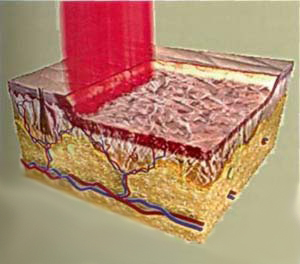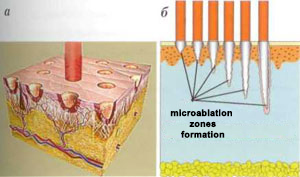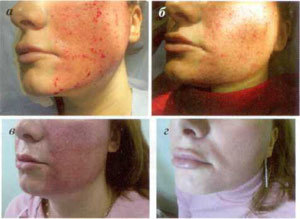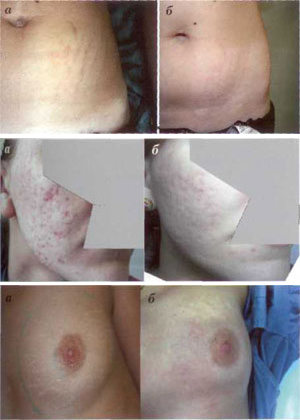Today, in the modern arsenal of skin measurements, there are many methods to correct cosmetic defects in the skin - chemical peels, mechanical abrasions, laser resurfacing, grindingskin micro-points, contouring and others. However, new trends and technologies in the beauty industry are constantly evolving and improving.
This trend is particularly typical of hardware methods, mainly for laser medicine. The use of lasers, first in dermatology, and then in cosmetology, has had an impressive period. Even the emergence of one of the laser treatments - selective photothermal - has gone on for more than 25 years. The pioneers of this field, the Americans RR Anderson and JA Parrish, foretold the fate of fractional lasers in medicine, making them indispensable in cosmetic treatment. skin blemishes such as capillary hemangioma. Wine stains, hypertrichosis, tattoos, rosacea, pigmentation disorders, photos, wrinkles, etc. v.
Modern skin resurfacing technique
We are living in a time when more people are living to get older than ever. And as many of them continue their active lives, one of the most important problems in cosmetic medicine is combating skin aging.
Plastic surgery can rejuvenate the shape of a face by removing excess skin. However, at the same time, the skin still changes with time (aging due to age) or external factors (influences). It is also important that most patients want to look younger without surgery.
In this case, what method should be used to impact the skin and what happens to truly rejuvenating skin?
All methods that can be used to improve the appearance of the skin are united by one principle - they use traumatic effects on the skin, causing fibrosis, leading to stretch andcompression.
Currently, dermatologists use three main types of skin resurfacing effects, including:
- chemical stimulation - acid peeling chemicals (trichloroacetic, glycolic, etc. );
- mechanical stimulation - mechanical skin abrasion, microscopic skin grinding, intermediate therapy, fillers, needle needle surgery;
- thermal excitation - laser excision, laser rectification and broadband light sources, radio frequency enhancement, fractionation method.
Chemical stimulation
Historically, acid exfoliation (exfoliation) was the first method of skin rejuvenation. The principle of peeling is to destroy partially (as with shallow peels) or almost completely (such as for intermediate and deep peel), damaging fibroblasts and dermis structures. This damage triggers an inflammatory response (the stronger, the greater the mass of self-destruction), leading to the production of more collagen in the skin.
However, in order to achieve the desired result, the peeling process sacrifices the cuticles. Experiments with burns have confused many people, thought to "prove" that the epidermis is a self-renewing organ that quickly recovers from damage. area. In this regard, the sloughing until some time becomes more and more intense against the epidermis (for example, phenolic deep peeling), until the accumulating problems eventually cause experts to takeOut the worst of this a method that ultimately leads to thinning of the skin.
Deep skin peeling advocates have been ignoring the emerging issues. Their nature is due to the destruction of the papillary shoots of the dermis and the weakening of nutrition, the epidermis becomes thinner and the number of cells in the papillary layer is significantly reduced compared to what was before peeling. . Reducing the barrier function of the stratum corneum leads to a decrease in skin moisture. (Therefore, almost all patients after long-term deep peeling suffer from severe dry skin. ) At the same time, the fact that lighter shells (using trichloroacetic and fruit acids) do not meet the hope ofTheir effective skin tightening.
Mechanical stimulation
Among the methods of mechanical stimulation to abnormal skin changes, the skin abrasion method uses a rotating device (with speed v; the rotation of the cutter up to 100, 000 rpm. ) deserves special attention. Currently, modern Schumann-Schreus devices are used (Germany)
This method can only be used in a surgical hospital, as it requires anesthesia, postoperative wound surface treatment, special cleaning of the eyes and mouth, as well as equipmentfor patients to eat (due to postoperative edema appearing 2-3 days after the procedure causing difficulty opening eyes and mouth).
This method is very effective, but unfortunately, with the method of mechanical abrasion there are many risks of complications such as:
- post-operative persistent congestion;
- appear areas of hypopigmentation due to destruction of melanocytes when the knife penetrates the basal membrane;
- wound surface infection;
- scar (if the knife cuts too deeply into the skin)
All of the above has defined the limited applicability of this approach in clinical practice.
Thermal stimulation
Retouch original
Since the late 1980s, lasers have been used to rejuvenate skin by removing tissue layer by layer (resection) [4]. Accurately removing the surface layer of the skin with a low level of trauma using a carbon dioxide laser stimulates its own collagen synthesis in which the amount increases several times after the procedure. After that, it is gradually reorganized.
The most effective is the use of CO2 lasers, when projecting a deep thermal impact into all layers of the dermis, manifesting outward with a firming effect. This method is called "laser skin abrasion", or "resurfacing laser", and is effectively unopposed by any of the other skin rejuvenation methods that existed at the time (Figure 1). ).

Image. 1. Traditional laser skin resurfacing scheme (laser skin resurfacing)
However, CO2 lasers also cause some major complications. Additionally, further studies have shown that the deeper effect on the dermis stimulates the formation of fibrous tissue to a greater extent than contributes to the synthesis of a normal new tissue. oriented collagen [5]. Developing fibrosis can cause abnormally pale skin. The collagen synthesized after the treatment is absorbed again after a few years, just like any collagen formed at the scar site. As a result of the thinning of the epidermis as the papillae layer of the dermis is atrophied, fine wrinkles begin to appear on the skin. Due to impairment of the barrier function of the stratum corneum, the hydration level of the skin decreases and appears to be atrophy.
The Erbium-aluminum-yttrium-erbium granite lasers appeared a little later. Such advantages of erbi lasers are a shallower thermal penetration depth (erbi laser penetrates to a depth of 30 μm, CO2 laser - up to 150 μm) and (therefore) a lower risk of burns and tissue carbonization, as well as its relatively cheap price (compared to carbon dioxide lasers), which has attracted the attention of many experts around the world.
However, as experience gained from working with these two types of installations, it was developed by experts that CO2 lasers are more efficient [6]. Despite the negative effects of the carbon dioxide laser skin care described above, this method is still indispensable for the correction of acne scars. Additionally, it can be considered an alternative to surgical skin tightening - in all its revamped methods, simply exposure to CO2 lasers can actually cause collagen constriction raco withThe muscle lifting effect is visible in the clinic.
The problem with all the methods described above is that they are often "sacrificial", ie significantly damaging the cuticles. To rejuvenate your skin and truly youthful, you need a perfect epidermis layer with natural papillae of the dermis, good hydration, normal skin tone and elasticity. The epidermis is a highly specialized highly complex organ, up to 200 microns thick, that is our only protective layer against the effects of negative environmental factors. So, whatever we do to rejuvenate our skin, we need to make sure its basic normal structure is never destroyed.
This concept has contributed to the emergence of non-stripped skin resurfacing technology.
Non-abrasive fix
The most common devices for non-ablative skin resurfacing are the neodymium (Nd-YAG) and the diode laser, as well as a broadband light source (IPL). Their principle of action - selective photothermal - involves heating and destroying the structure, containing a sufficient amount of melanin or oxyhemoglobin. In the skin, this is an accumulation of melanocytes (melasma, darkening) and microscopic (telangiectasia). The emitted wavelengths used in non-dissociation lasers correspond to the maximum of the absorption spectrum of oxyhemoglobin or melanin. The IPL and non-dissection laser treatment procedure is quite safe, the rehabilitation time is minimal, however, such treatments only remove pigmentation and cosmetic defects. In this case, the skin will definitely thicken, but the effect is short-lived.
fractional skin resurfacing techniqueConstantly searching for new highly effective and at the same time safe skin rejuvenation methods has led to the emergence of a revolutionary technology - fractionation of laser radiation. The proposed skin rejuvenation method has been specifically designed to overcome some of these problems. Unlike the "conventional" ablation and non-dissection laser methods, which are designed to achieve uniform thermal damage on the skin at a specific depth, the fractionation methods allow to achieve micro-thermal damage. Its selective tissue in the form of multiple columns is altered and leaves untouched areas around these microscopic wounds. Currently, the industry produces two types of fractional lasers: non-ablative and ablative.
First use an erbium-doped fiber to generate radiation at a wavelength of 1550 nm. Fractional lasers form in the skin thousands and tens of thousands of microscopic points in the form of columns - the micro-thermal treatment (MLZ) - with a diameter of 70-150 mk depth up to 1359 mcm
As a result, about 15-35 skin is coagulated on the treatment area. The color carrier of the laser is water. Coagulation occurs mainly in the lower layers of the epidermis and dermis. The horny layer remains intact because it contains a relatively small amount of water, and this significantly reduces the risk of infection. The epidermis recovers rapidly due to the low volume of damage and the short travel distance of the keratinocytes. Healing is accompanied by moderate swelling and congestion, followed by desquamation, which appears on day 5-7. Practically the patient does not lose social activity.
This technology - fractional photothermal (FF) - is a highly efficient method of fractional skin resurfacing. To achieve the desired effect, a course of treatment is prescribed. Depending on the clinical situation, it is recommended to do 3 to 6 courses at intervals of 4-6 weeks. As with any other non-dissolving skin resurfacing method, the end result can be seen only 4-8 months after the procedure (cumulative effect).

In the event of a more positive impact on the skin - to correct scarring, remove deep wrinkles and excess skin, fractional resection (FA, or fractional deep cut-FDDA) is used. .
The fractional ablation method combines the advantages of CO2 lasers and the fractionation principle of fractionation of laser radiation. In contrast to traditional CO2 lasers, which remove the entire skin surface layer by layer, the FA units form a large number of regional microparticles (MALs) up to 300 µm in diameter at evaporation depths from 350 to 1800. µm (Image 2).
Thus, in this process, laser radiation penetrates deep layers of the skin, destroying the upper layer of the epidermis. In terms of effectiveness, fractional laser resection can be compared with plastic surgery, this is the depth of the laser surface.
Image. 2. Working principle of abrasive fractional lasers: formation of microwave zones - MAZ (a); the MAZ forming depth dependence on the laser radiation power (b)
As in the case of FF, 15 to 35% of the actual skin is exposed (in some cases up to 70%). Faster recovery from FA procedure after layer removal. This is due to the fact that part of the epidermis and horny layer are still intact. Skin bleeding is observed for a while immediately after the procedure, but it will soon stop (Figures 3 a, b).
Image. 3. Step-by-step skin restoration after fractional resection: see immediately after treatment (a); every other day (b); after 5 days (c); 14 days (d) after a
procedure
Multiple microscopic particles appear in the dermis, creating a complex series of changes that lead to new collagen production. After the bleeding stops, it is necessary to remove the serum remaining on the skin surface. Its release is observed within 48 hours after the procedure, until complete epithelization of microscopic regions occurs. During this period, the patient uses special agents that heal external wounds. Usually starts 3 to 4 days with flaking and increased swelling (Figure 3 c). By day 7, these phenomena subside and erythema remains the only noticeable side effect (Figure 3d). The duration of erythema depends on the parameters of the laser exposure and the skin vessel features. According to the author's observations, erythema lasts no more than 3 months.
Inactive patient after FA procedure lasting 5 to 10 days.
To prevent scarring and manifestations of post-inflammatory pigmentation, careful skin care is required. Decorative cosmetics can be used from 4-5 days. A prerequisite for good results is to use for at least 3 months after using a high-level of protection sunscreen (SPF of at least 50). The risk of post-inflammatory pigmentation occurs in 20% of patients and is generally higher in patients with IV-V radiographs. This hyperpigmentation is transient in nature and can last from 1 week to 3 months, depending on the extent of treatment depth and area of treatment. For its prevention 1-2 weeks before the procedure and for 2 weeks after that, external agents based on hydroquinone (4%) and tretinoin (0, 1%) are prescribed. The main effects on the facial skin after FA treatment are as follows: visibly tightening and reducing excess skin, smoothing the surface of wrinkled skin, as well as skin affected by acne scars, reducing pigmentation disorders and porosity.
This method has been tested by the author and his colleagues to also remove stretch marks on the skin. According to clinical studies, this method has proven highly effective in removing most types of stretch marks, even during puberty. period and postpartum. It should be noted that the skin healing process of body is different from that of the face.
Mechanism of skin regeneration using
fractional lasersTake a look at the mechanisms for skin resurfacing using fractional lasers.
After exposure to the laser, aseptic inflammation develops in the area where microscopic wounds are formed. The stronger the exposure to the laser, the more pronounced the inflammatory response, in fact, provokes the post-traumatic release of the growth factors and the infiltration of the tissue damaged by fibroblasts. The impending response is automatically accompanied by an explosion of cell activity, which inevitably leads to the fact that the fibroblasts begin to produce more collagen and elastin. The skin regeneration process consists of three classic regeneration stages:
- stage I - change (inflammation of the tissue). Start right after the break;
- stage II - proliferation (tissue formation). Starts 3-5 days after the injury and lasts about 8 weeks;
- stage III - tissue regeneration. Lasts from 8 weeks to 12 months.
It should be noted that all three phases of skin regeneration are observed both after fractional photothermal and after fractional ablation. But in the first case, the damaging effect of the laser beam is moderate, so producing a variety of inflammatory changes is never too wild.
A completely different picture is observed after laser cut the segment. This laser injury causes the rupture of blood vessels, and blood cells along with serum are released into the surrounding tissue. Official mechanism of skin regeneration - begins to change - aseptic inflammation develops. Platelets released from damaged vessels play an important role in activating blood clotting and releasing chemical toxic factors, in turn, platelets, white blood cells and other fibroblasts. be attracted. Leukocytes, especially neutrophils, are involved in the cleaning of damaged tissues, removal of necrotic tissue fragments, partly destroyed by phagocytitis, and partly by passing to the lower skin surface. The form of microscopic particles including the epidermal and dermis stroma and melanin - microscopic necrotic debris (MENO).
The proliferation phase starts after about 5 days. During this period, the neutrophils are replaced with mononucleosis. Mononuclear cells, keratinocytes and fibroblasts continue to influence the growth factors and at the same time suffer their opposite effects. Keratinocytes stimulate the growth of the epidermis and release growth factors needed to stimulate collagen production by fibroblasts. During this stage, new blood vessels are formed and the extracellular matrix is strongly formed.
The final, regenerating, healing phase after fractional laser exposure lasts several months.
On the 5th day after injury, a fibronectin "joint" matrix along the axis where fibroblasts are lined and along which collagen will be built. An important role in this matrix formation is played by converting growth factor β (TGF-is a chemical toxic to fibroblasts), as well as other growth factors. The main type of collagen in the early stages of the wound healing process is type III collagen (this type of collagen is located in the upper layer of the dermis, just below the bottom layer of the epidermis). The longer the phase of change, the more collagen type III will be produced, but in any case its collagen intake maximizes 5 to 7 days after the injury. Type III collagen is gradually replaced by collagen over about a year Type I, which strengthens the skin. Blood circulation is gradually normalized, the skin becomes smoother and acquires natural color.
Comparative analysis of laser skin resurfacing methods
Summarizing the above, here is the diagram showing the relationship between the effectiveness and safety of laser skin resurfacing.
The advantage of the groove rejuvenation method. The advantages of the fractional approach used in clinical practice include:
- minimizes skin damage. Histological studies performed after the procedure showed an increase in papillae number in the dermis, characteristic of changes in the skin upon effective regeneration;
- effective rejuvenation: skin becomes thicker, significantly (more than 400% (! )) increases collagen and elastin production;
- short healing time: average 3 days after FF and 7-14 days after PA;
- minimal risk of hyperpigmentation;
- ability to perform the procedure in thin-skinned patients;
- the ability to have a healing effect on any part of the body;
- possibility of using mild anesthesia: with fractional photovoltaic, only local anesthesia is used; for fractional ablation, a combination of conduction anesthesia and infiltration is required;
- the disappearance of telangiectasias (due to the rupture of blood vessels in many places, their restoration is impossible).
Main indications for
fractional treatments
Specifies the fractional photothermal:
- increases skin density in the early stages of the aging process. The FF process is relatively easy and can be done without fear. The therapeutic effect can be performed on the neck, chest, arms, abdomen, thighs, mammary glands;
- photographed skin;
- hyperpigmentation, pigmentation;
- hypertrophic scar; Stretch marks
- .
Specifies to Cut Fractions:
- wrinkles of varying severity - from fine to distinct fine lines (in the form of fine lines);
- loses age-related elasticity and firmness;
- excess skin on eyelids, neck, face (replacing plastic surgery);
- uneven skin texture;
- takes clear skin shots;
- acne scars;
- skin deformity after trauma, surgery;
- hyperpigmentation: melasma, melasma, pigmentation spots, etc. v.
- vascular pigmentation disorder;
- stretch marks;
- actinic horny.
In short, there are a few words about the prospects of using laser technology in cosmetic medicine. We must thank manufacturers that they have begun to pay more attention to the safety of medical procedures that use lasers. Technology is constantly evolving. Often, however, the safety of this approach has been sacrificed to increase its effectiveness. Or vice versa. A compromise was found in a new principle of the distribution of laser radiation to tissue. It should be noted that the lasers remain the same: erbium, carbon dioxide, neodymium. This shows that:
- first of all, the most effective laser skin resurfacing available today; Second
- , the coverage of cosmetic and dermatological problems addressed by these methods is extremely large - from skin rejuvenation to treatment of congenital and acquired skin diseases; The third
- , with the advent of fractionation technology, the safety and efficacy of the treatment became predictable.














































































